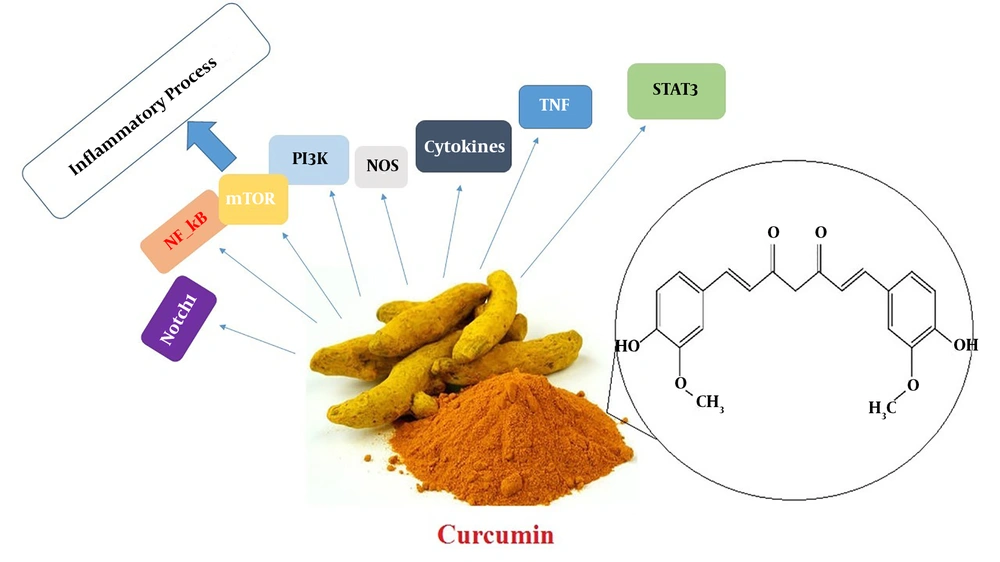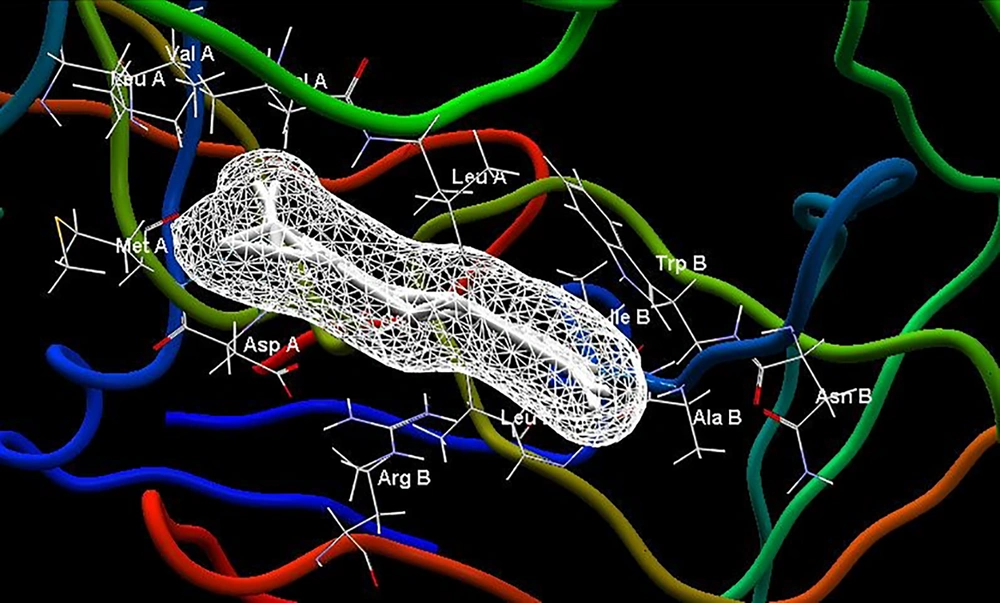Dear Editor,
Curcumin is a natural product of Curcuma longa L (turmeric) plant, which has remarkable roles in various biological fields and its properties consist of antioxidant and anti-inflammatory activity, anti-arthritic and anti-diabetic effects, lipid metabolism, protective role against cardiovascular diseases and ischemia, and the regulation of neural process (1). Recently, it has been suggested about the potential effects of Curcumin against pathogenic microorganisms such as bacteria, fungi, and viruses (2). According to the literature, Curcumin has anti-viral effects on virulent viruses such as HIV, HTLV-1, HBV, HCV, HPV, HSV, JEV, influenza, and Coxsackievirus. Although this yellow chemical could be taken into account as a unique anti-viral herbal drug, especially for enveloped viruses, it has no toxic effects on the human cell-line viability. Moreover, based on immunological studies, Curcumin can influence various immune responses such as mitogen-activated protein kinases (MAPKs), phosphoinositide 3-kinase/protein kinase B (PI3K/PKB), nuclear factor kappa B (NF-κB) pathways, as well as dysregulate the ubiquitin-proteasome system (Figure 1) (2, 3).
Considering the emergence of drug-resistant viruses (particularly HIV) on the one hand, and low efficacy, high cost, toxicity, and low bioavailability of current anti-viral drugs, on the other hand, returning to the traditional herbal medicine is considered an alternative approach. In addition, cost-effectiveness, accessibility, and low toxicity in the human are among Curcumin’s properties (2, 4, 5). Curcumin and its analogues have significant effects against retroviruses, particularly HTLV-1, which has currently no effective treatment (6). Nowadays, HTLV-1 infections are treated using Zidovudine plus IFN-α that are inefficient in some cases. Thus, owing to the lack of selective specificity, several anti-viral components (e.g. Lamivudine) have been rejected by HTLV-1 (7, 8).
HTLV-1 is retrovirus type C, which is known as the first human retrovirus. This RNA virus was firstly discovered by Poiesz from cutaneous T-leukemia in 1978 (9). It is estimated that 15 - 20 million people are infected with HTLV-1 worldwide. Mostly, they live in endemic areas such as South of Japan, the center of Africa, Latin America, the Caribbean island, Australia, and the Middle East. Although more than 90% of infected cases are as asymptomatic carriers, approximately 2% - 6% of cases develop to the Adult T cell leukemia/lymphoma (ATLL). Also, 2% - 3% of cases progress to HTLV-1-associated myelopathy/tropical spastic paraparesis (HAM/TSP) (8, 9).
The retroviruses have encoded three enzymes, protease (PR), reverse transcriptase (RT) and integrase (IN), which are responsible for viral replication and retroviral pathogenesis (8). Similar to the HIV protease, HTLV-1 protease is a homodimer protein and each subunit is composed of 99 amino acids. The enzyme is responsible for the hydrolysis of HTLV-1 polyproteins during infection in an acid-base reaction via two aspartic acid residues (Asp32, Asp36), which are located at its active site (10). Interestingly, HTLV-1 can spread in the body via cell-to-cell transmission by virological synapse (11). Therefore, it is suggested that protease, reverse transcriptase, and integrase are not appropriate targets for the development of effective anti-HTLV-1 drugs because the activities of HTLV-1 enzymes are not completely stopped during the infection and continue in low expression level. Having multiple targeting compounds Curcumin can inhibit HTLV-1 replication by a direct effect on HTLV-1 and simultaneously improve signaling pathway inside the cells (11, 12). The aim of this study was the evaluation of Curcumin as a potential candidate for an anti-viral drug against HTLV-1 infection using molecular docking analysis. Since the crystal structure of RT and IN enzymes are not currently resolved; hence, this study focuses on HTLV-1 protease.
The crystal structure of the HTLV-1 protease was obtained from PDB online server (3WSJ). In the next step, the molecular structures of Curcumin and Indinavir were obtained from NCBI PubChem. Then the polar hydrogens and kollman charge were posed for all ligands and receptors. The molecular docking assay was performed using the Lamarckian genetic algorithm in AutoDock Vina software with parameters in Cartesian grid, including 38.384, 0.159, and 20.934 in grid box of 28, 32 and 36 as X, Y and Z axis, respectively.
Overall, Curcumin is evaluated as a suitable HTLV-1 Protease inhibitor based on molecular docking results (Table 1). It can enter the active site of the HTLV-1 protease and interacts with several residues of the active site region (Figure 2 and Table 1).
| Ligand Name | Binding Energy | Amino Acids in Interaction |
|---|---|---|
| Curcumin | -8.1 | Arg10, Gly34, Asp36, Met37, Trp98, Ala99 |
| Indinavir | -11.1 | Asp32, Gly34, Asp36, Val 56, Gly58, Ala59, Ile100 |
The Molecular Docking Analysis of the Curcumin and Indinavir with the RMSD of ≤ 2.0 Å
The results of the present study showed that Curcumin has better properties to inhibit HTLV-1 protease compared to KNI-peptidomimetics. The S3/S3' pocket of HTLV-1 protease has six residues, including Arg10, Leu30, Asp36, Leu57′, Asn97, and Trp98, which three residues of Leu57′, Asn97, and Trp98 are exclusive in HTLV-1 protease structure. The Curcumin interacts with Asp36, Arg10, and Trp98 in S3/S3′ pocket.
Li et al. showed that unique residues of Trp98 and Leu57′ make a hydrophobic pocket of S3/S3′. Moreover, Trp98 is covered with Asn97, which is considered to be the main amino acid in active site residues. Therefore, the blockade of Trp98 is important for designing HTLV-1 protease inhibitors. The hydrophobic nature of Curcumin causes that it not to be rejected by HTLV-1 protease, as well as the blockade of Trp98 (13).
According to Selvaraj et al. study, the amino acid of Asp30 in HIV-1 protease is substituted with Met37 in HTLV-1 protease. Met37 is the pivotal amino acid responsible for rejection of HIV protease inhibitors against HTLV-1, and Curcumin can bind Met37. Also, the active site of the HTLV-1 protease is hydrophobic and Curcumin due to its hydrophobic nature can enter and reacts with active site residues of HTLV-1 protease (Figure 3) (14).
We used Indinavir (a conventional protease inhibitor) as a control for the evaluation of Curcumin ability to inhibit the HTLV-1 protease activity (Table 1). Although Indinavir was evaluated as better HTLV-1 inhibitor in molecular docking analysis, it is necessary to be suggested that Indinavir has several disadvantages, including limited absorption dosage, low half-life, and serious side effects such as toxicity for human cell lines. In contrast, the Curcumin can function more effectively compared to Indinavir due to its safety for human even in high dosage (15).
Owing to low solubility and bioavailability, the Curcumin is not suggested to be used as a therapeutic approach, but we should note that the Curcumin metabolites such as curcumin-sulfate, curcumin-glucuronide, and tetrahydro-curcumin have strong properties of therapeutic drugs (1). In addition, the Curcumin has multiple functions and influences the immune-response beside its direct activity against pathogens (16). Therefore, modified pharmacophores derivative of the Curcumin can be as the worthwhile candidates for the treatment of HTLV-1 infections, particularly as potential HTLV-1 protease inhibitors.



